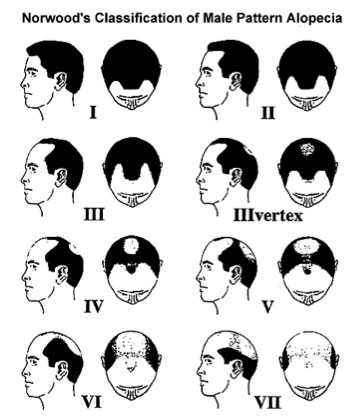The most common form of hair loss in men is called androgenetic alopecia. It is prevalent and caused by a genetic predisposition passed through a patient’s parental lineage on either side. This type of hair loss is caused by the genetically-predisposed impact the male hormone dihydrotestosterone (DHT) has on certain hair follicles of the scalp. DHT can impact certain follicles to shorten a hair’s growth phase (anagen phase), and progressively thin hair until it becomes permanently lost.
Patients can have varying starting points in life for the beginning of the hair loss cascade. Some patients begin losing hair as early as their teenage years and early 20’s. Others can begin losing hair in later decades. The patterns of androgenetic alopecia are typical and often characterized by a standardized Norwood Classification as follows:

These typical distributions of hair loss, along with qualification of hair loss and family hair loss history, usually allow for the easy diagnosis of androgenetic alopecia. There are additional confirmatory signs for this diagnosis which include the biologic phenomenon of hair miniaturization. This is a process whereby the hair shaft diameter and overall length and caliber “miniaturize.” This process confirms the diagnosis of genetically-programmed androgenetic alopecia. Androgenetic alopecia is the type of hair loss we typically classify, study, predict, and treat as surgeons. Clinicians must adequately understand the other less common causes of hair loss in men, which are various in nature, sometimes correctable, and often not amenable to hair surgical treatment.
Hair loss in women is also often a genetically-predisposed pattern of hereditary alopecia. However, the surgeon needs to exclude other common possible causes which include various hormone-related abnormalities, thyroid function disturbance, elective birth control impact, pregnancy, certain medications, iron-deficiency, impact of excessive hair-styling techniques, among others.
Furthermore, the pattern of genetically-predisposed hair loss in women is often diffuse across the scalp. This pattern can be the same as that for other medical causes of hair loss in women. Thus, the hair surgeon requires careful diagnostic acumen when differentiating causes. Patterns of female hair loss are typically categorized by the Ludwig Classification system as follows:

The typical presentation of androgenetic alopecia in women is similar to that in men. Hairs will become progressively miniaturized, thinned, and lost. While the distribution of loss differs (usually diffuse across the top of the head), the progressive nature and predictable pattern over time is similar to that in men. Just as that for typical “male-pattern” baldness, female hair loss can be medially stabilized, and effectively treated with robotic or incisional surgical techniques.
For women traveling a distance to our Institute, we often advise completion of a thorough medical work-up by a treating primary care physician or dermatologist, to first rule-out other correctible causes of hair loss.